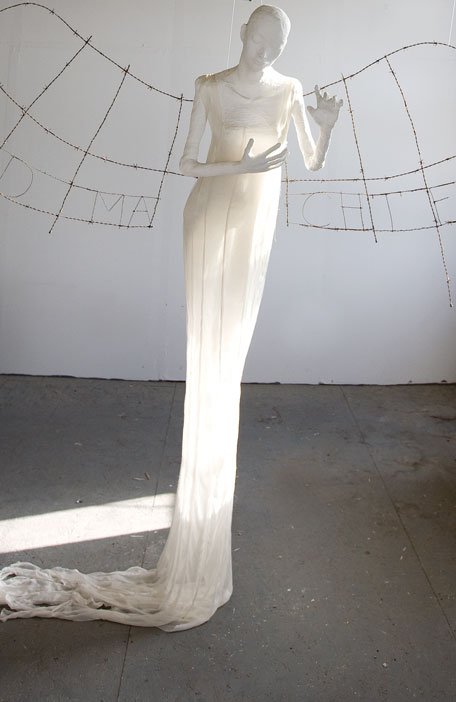In the national premiere retrospective of her work, “Blood Memory: a view from the second generation,” artist Lisa Rosowsky explores the “second generation” experience as the daughter of a hidden child and refugee from the Holocaust. Themes of repression and loss emerge, as do memories and stories about a family decimated by war.
Rosowsky, a Massachusetts-based artist, works in a variety of media, but is especially attracted to fabric. The translucency of silk, voile or gauze —and the images seen both on or through the cloth — is for her like the transience of memory, and the fading into history of the few remaining relatives who can speak of these memories.
Rosowsky writes that “blood memory” is “the knowledge that cannot possibly be handed down, but is, and it lies at the heart of my work as a visual artist.” In her exhibition, this knowledge is represented through a variety of media, including quilting, sculpture, printmaking and installation. One compelling piece, “The Raitzyns” (2004), is a hand-made quilt of 11 family photographs juxtaposed with a selection from Raya Raitzyn’s antique glove collection. The white gloves indicate who survived the war, and the black gloves, those who did not.
Rosowsky’s paternal family lived in France during World War II. As Jews, they became the targets of the Nazis, who invaded Paris in 1940. In July 1942, Rosowsky’s paternal grandparents, Vladimir and Tamara, were arrested as a part of La Grande Rafle (The Great Raid), sent to the Drancy internment camp and later to Auschwitz, where they were murdered. Before their arrest, Vladimir and Tamara were able to secure hiding for their son, André, in the area of France then not occupied. Their selfless sacrifice – what one Holocaust scholar calls a “choiceless choice” – led to their son’s survival.
Rosowsky says, “I did not directly suffer or even witness the horrors of the Holocaust, but they live on in me nonetheless. They live on in a lifetime of terrifying dreams; in the nameless fears of my childhood.” More than simply “Holocaust art,” Rosowsky’s work is about what it is like to inherit a legacy of silence and absence, and to transform it through art that is both personal and universal.
Rosowsky is a member of the faculty at Massachusetts College of Art and Design, where she teaches typography and book design. She holds a bachelor’s degree from Harvard College and a master’s degree in graphic design from Yale University. Her studio is in a converted hat factory in Framingham, MA.
The exhibit is generously underwritten by Venetian Blind Carpet One in memory of Charles Streusand; the Nina and Michael Zilkha Endowment Fund and Holocaust Museum Houston’s Corporate Chairman members: Baker Botts LLP; Frost; the Halliburton Charity Golf Tournament; H-E-B; Marathon Oil Corporation; and the Morgan Family Foundation; with special thanks to United Airlines, official airline of Holocaust Museum Houston.
For more information about the exhibit, call 713-942-8000, ext. 128, or e-mail exhibits@hmh.org.


